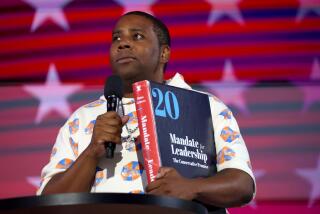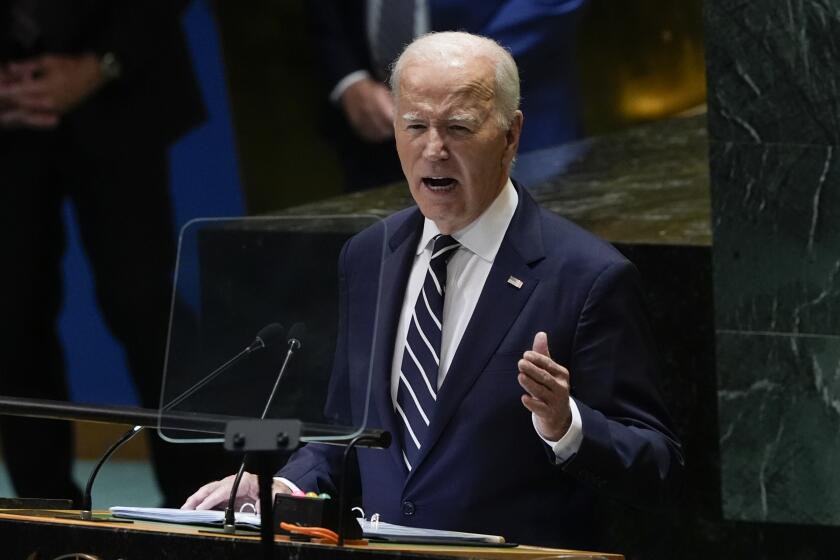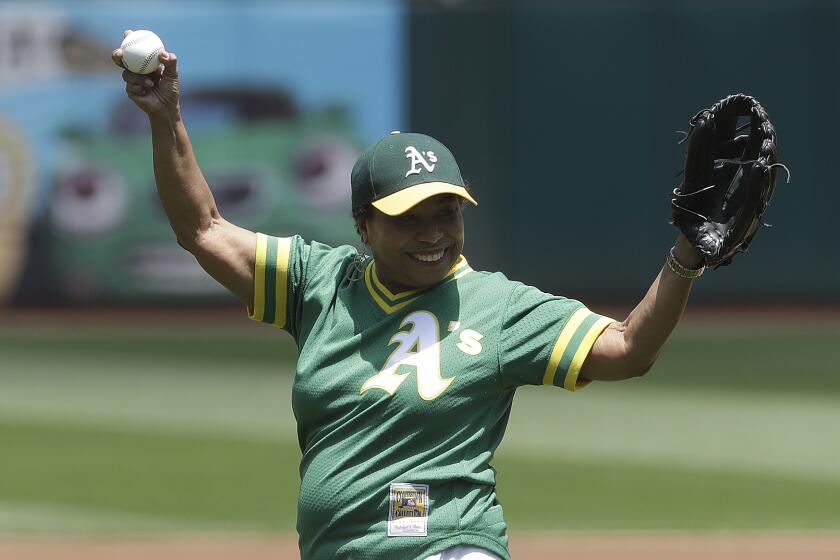Trump loses ground among key voter groups, tracking poll finds
Donald Trump’s standing among key voter groups has steadily dropped for more than a week, erasing the lead the Republican nominee once had in the presidential contest, according to the latest findings from the USC Dornsife/Los Angeles Times national tracking poll of the race.
What’s striking about the trend is not Hillary Clinton’s rise — typically, candidates get a boost from their nominating conventions, and the Democrat’s post-convention increase of about five percentage points is only slightly above average.
More significant is the scope and breadth of Trump’s decline. A week in which he has repeatedly generated controversies that have dismayed fellow Republicans has wiped out virtually all the gains Trump made as a result of the GOP convention.
About one in five voters in the survey grew significantly less supportive of Trump during the last week. Roughly an equal number became more supportive of Clinton.
As of Saturday, the poll showed Clinton at 44.6% and Trump at 44.2%, well within the survey’s margin of error. Her margin could grow in coming days as the poll, which reflects a seven-day rolling average, moves away from the period in which Trump was at his peak.
Separately, the poll also asks voters which candidate they think will win. That question has often shown greater ability to predict election outcomes than asking people who they will vote for, particularly when the election remains months away.
Clinton leads that voter expectations question by a large margin, 53%-42%. After the Republican convention last month, Trump had briefly narrowed the gap on that question, but Clinton has rebounded sharply over the past week and a half.
Other surveys released this week have found the same trend toward Clinton, but have shown her with a bigger lead:
An NBC/Wall Street Journal survey found Clinton up nine points, 47%-38%. Fox News’ latest poll had Clinton up 10 points, 49%-39%. CNN had Clinton up by nine points, 52%-43%, and CBS by six. A poll by Marist College for the McClatchy newspapers had the largest Clinton lead of all, 15 points.
Averages of recent polls show Clinton with roughly a seven-point lead as of Saturday.
Polls of swing states have also showed Clinton leading.
Surveys released this week by nonpartisan polling organizations had Clinton up by four points in Florida, nine in Michigan, 13 in Pennsylvania and 15 in New Hampshire, all in hypothetical four-way match-ups that included Libertarian candidate Gary Johnson and Green Party nominee Jill Stein.

President Obama declared Tuesday that Donald Trump is unfit to serve as commander in chief and called on Republicans to rescind their endorsements of their presidential nominee.
A poll by the Atlanta Journal-Constitution even found Clinton leading Trump by a small margin in Georgia, a state Democrats have not carried in a presidential election since Bill Clinton’s first victory in 1992.
The tied result in the USC/L.A. Times Daybreak poll stems in part from the seven-day rolling average, which minimizes the volatility that can lead to polls exaggerating the highs and lows of a campaign. When large numbers of voters do change their minds in a short period, however, the average can cause the poll to lag.
Some analysts have also suggested that the way the poll is weighted has shifted the results a few points in Trump’s favor.
Every poll weights results in order to make sure the survey sample matches known demographic facts, such as the right percentages of men and women or older and younger voters. Each poll does that process differently, and until the votes are counted, there’s no way to know for sure which method was right.
The great strength of the Daybreak tracking poll is that it allows close analysis of exactly which groups of voters are moving toward or away from each candidate.
The poll uses a different methodology than most election surveys. Instead of randomly contacting a different set of people for each survey, it uses a panel of roughly 3,200 eligible voters, selected to be representative of the U.S. electorate. Those people are resurveyed continuously, roughly 300-400 per day.
As a result, shifts in the candidates’ standings reflect actual people changing their minds as opposed to variations in who responds from one survey to the next.
Using a 0-100 scale, the poll asks voters to estimate the chance that they will vote for Clinton, for Trump or for some other candidate.
Each week, the poll has found that about three-quarters of the voters don’t significantly shift their preferences. At the other end of the scale, very few do a complete turnaround — going from wholehearted support of Trump, for example, to strong support for Clinton.
About four in 10 voters say they have a zero percent chance of voting for Trump and roughly the same share say they have a zero percent chance of voting for Clinton.
But in each of the poll’s four weeks so far, 20%-25% of the voters have shifted a significant amount — a reminder that with three months yet to go in the campaign, a lot of voters have not firmly made up their minds.
Most of those who shift move between six and 25 points. That could be a voter who goes from being 80% likely to vote for Trump one week to 60% the next, or one who moves from leaning toward Trump to leaning toward Clinton.
Election 2016 | Live coverage on Trail Guide | Sign up for the newsletter
In some weeks, the voter shifts amount to a churn in which those moving toward a candidate largely cancel out those moving away.
During the week of the Republican convention, for example, about one-third of female voters had significant shifts in their attitudes toward Clinton. But those becoming more positive roughly equaled those becoming more negative.
Then there are weeks like this one — the survey’s fourth — in which the movement of voters is lopsided.
The data so far for this past week show Trump has lost ground even among some of the groups that have given him the strongest support. More than 1 in 5 white voters soured on him, for example, as did a similar share of voters older than 65. In both groups, only about half as many voters moved in Trump’s direction.
Even white voters without a college education, who have formed the core of Trump’s support, shifted against him in the past week. About 1 in 5 of those blue-collar, white voters moved away from Trump this week, compared with about 1 in 10 who moved toward him.
Trump leads among whites by 54%-34% while Clinton leads 84%-4% among black voters. She has about a 2-1 lead among Latinos.
For Clinton, the movement of voters in her direction began late in the third week of the poll, immediately after the Democratic convention. About 1 in 5 women became more supportive of her in the last two weeks, along with a similar proportion of men in the last week alone.
Similarly, older voters — who typically pay closer attention to politics than younger voters — moved strongly toward Clinton in the survey’s third week. Voters younger than 45 moved more heavily in the past week.
A noticeable number of voters also shifted support between one of the two major candidates and “other.”
In some cases, that category, which could include backers of Johnson, Stein or some other person, can serve as a placeholder for voters moving away from one of the two major candidates but not ready to commit to the opposing one.
Over the last four weeks, however, aggregate support for the two major candidates has increased, and support for other candidates has declined. When the poll began on July 10, about 80% of support in the poll was for either Clinton or Trump; now that’s risen to roughly 90%.
In addition to the overall margin, other surveys released during the past week have delivered good news to Clinton and indicated trouble for Trump.
For example, the newly released Franklin & Marshall College poll in Pennsylvania, a state that Trump almost certainly would have to win this fall, showed a huge gap in the preferences of white voters with a college education versus those without.
See the most-read stories this hour »
College-educated whites in the state favored Clinton 58%-28% while whites with a high school degree or less favored Trump 53%-31%. The latest NBC/Wall Street Journal survey shows a similar, albeit smaller, gap nationwide. College-educated whites favored Clinton by seven points in that poll.
A trade-off in which Republicans gain among blue-collar whites but lose ground with white college graduates is exactly what Republican strategists have feared would happen with Trump.
His style, and the issues he has focused on, appeal to blue-collar, white voters — a shrinking part of the electorate — but threaten to turn off college-educated voters, whose ranks are increasing.
If Clinton wins college-educated white voters, she would be the first Democrat to carry that group since at least 1952, which is as far back as polling records extend.
For more on politics and policy, follow me @DavidLauter
ALSO
San Diego roadside sign hacked with profane message about Trump
In complicated Ohio, Trump and Clinton swap voters as they vie for a key state
UPDATES:
9:10 a.m. Aug. 6: This article was updated with Saturday’s tracking poll results.
The article was originally published at 3 p.m. Aug. 5.
More to Read
Get the L.A. Times Politics newsletter
Deeply reported insights into legislation, politics and policy from Sacramento, Washington and beyond. In your inbox three times per week.
You may occasionally receive promotional content from the Los Angeles Times.











